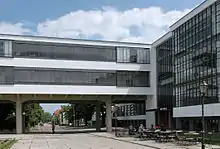City of London Pedway Scheme
The City of London Pedway Scheme is a largely elevated pedway network that evolved out of a plan to transform traffic flows in the City of London by separating pedestrians from street level traffic using elevated walkways. First devised as part of the post World War II reconstruction plans for London, it was put into effect mainly from the mid-1950s to the mid-1960s, and had been largely mothballed by the 1980s. The scheme was partially revived in 2017 when a new section of walkway was added as part of a development in London Wall.
.jpg.webp) The new London Wall section | |
| Overview | |
|---|---|
| Owner | City of London Corporation |
| Locale | City of London, England |
| Transit type | Pedway |
| Number of lines | 9 |
History

Versions of the plan had been under consideration since the 19th century, and given shape by the German Bauhaus movement, but the scheme was only given impetus in London after World War II, during which London had suffered severe bomb damage. Enthusiasts for the scheme saw an opportunity to put it into practice through the post-war reconstruction programme, and in 1947 architect Charles Holden and planner William Holford developed a blueprint that envisaged a network of first-floor walkways that would connect buildings across the City.[1]
By the mid-1960s, the City of London Corporation had incorporated the scheme into its development plan. Although no coherent network was ever defined,[2] designers of new developments were required to incorporate first-floor access to the Pedway network as a condition of being granted planning consent. As most of the network had not been built, this meant that many developments incorporated unused "dead space" at first-floor level and partial walkways that led to dead ends. In consequence, the scheme was unpopular with many architects.[3]
Buildings that were required to incorporate links to the Pedway included the National Westminster Tower, which incorporated a pedestrian bridge across Bishopsgate that was never used and is now demolished; the Commercial Union building, the Barbican, and Draper's Gardens.[1]
By the mid-1980s, the scheme had effectively been discontinued. The reason for its ultimate demise were escalating costs and the increase in influence of the conservation lobby, which opposed the extensive redevelopment of the historic areas of the City. The Pedway scheme only succeeded in establishing itself in areas that required extensive post-war reconstruction. The most extensive part of the network to be completed was in the Barbican Estate and surrounding streets; the main entrance to the Museum of London is, to this day, at first-floor level. Other significant stretches of the Pedway network were built in Lower Thames Street, Cannon Street and around the former Stock Exchange building.[1]
In 2017, the pedway scheme was revisited when section of walkway was added as part of a new development on London Wall.[4][1]
List of City of London Pedways
The list below shows routes of pedways on OpenStreetMap[5]
- The Barbican Highways(including the new London Wall walkways)
- Blackfriars / Baynard House pedway
- Peter's Hill pedway (all at ground level)
- Fyefoot Lane pedway
- Suffolk Lane pedway
- Swan Lane pedway (all that remains of this pedway is a staircase to a landing)
- Pudding Lane pedway
- Bishopsgate pedways
- Middlesex Street Estate (currently no public access)
Pedways in other places
Pedways were planned, implemented and demolished in many other UK cities. In Manchester, there were the Hulme Crescents . T Dan Smith planned the Streets in the Sky in Newcastle. There was a scheme planned and abandoned in Liverpool, leaving Liverpool Moorfields station with subterranean track, but a first floor booking hall. [1]
In Europe, pedways exist in Paris La Défense and Beaugrenelle area, Lyon in La Part Dieu area, Bordeaux in Mériadeck area ...
Pedways (and pedestrian tunnels) have been more successfully implemented in other parts of the world especially where fully enclosed connections allow year-round use even during inclement weather. They are sometimes called skyways. Examples include Central Elevated Walkway in Hong Kong, providing protection from heat and humidity, and PATH in Toronto, +15 in Calgary and the Minneapolis Skyway System, providing protection from cold.
References
- Wainwright, Oliver (2 October 2018). "Walkways in the sky: the return of London's forgotten 'pedways'". The Guardian. Retrieved 7 October 2018.
- The Pedway: Elevating London, by Chris Bevan Lee (at 28 minutes)
- L. Humphries (1974), "Architecture of the Gollins Melvin Ward Partnership" ISBN 978-0-85331-368-7
- "Pavements In The Sky: Return Of The City's Pedways". Londonist. 20 April 2017. Retrieved 24 June 2018.
- "Pedways of the city of London". October 2017. Retrieved 7 October 2018.
External links
- This documentary about the City of London Pedway Scheme, The Pedway: Elevating London, was made in 2013 by filmmaker Chris Bevan Lee.
- Moore, Rowan (1 July 2018). "London Wall Place review – a high walk back to the future". the Guardian. Retrieved 7 October 2018.
| Wikimedia Commons has media related to Highwalks in the City of London. |
